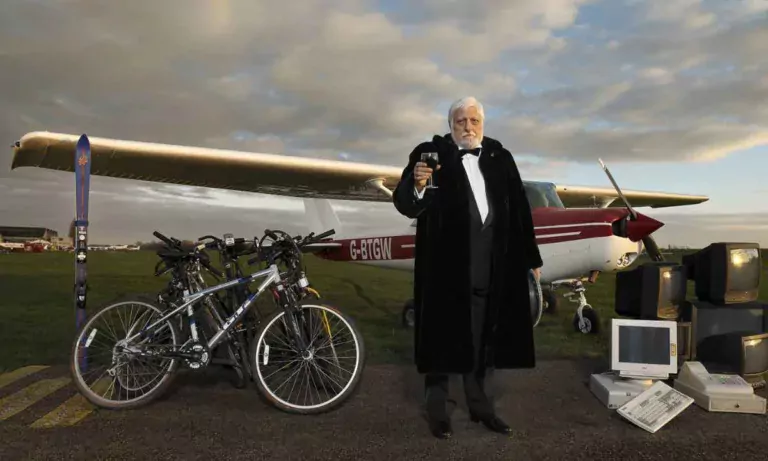This baby was raised with a baby chimp to teach it human behavior, But the Results Were a Disaster
In the early 1930s, two psychologists started a weird and controversial experiment to explore the boundaries of nature versus nurture. They raised a baby chimpanzee alongside their own infant son, treating them exactly the same. However, after nine months, the results were not what they expected—their human child began to exhibit chimp-like behaviors.
This is not the strangest part of the story. Not only did the child start to make sounds like a chimp, but the chimp also started to act like a human child and developed some extra motor skills. It’s just the beginning of the story. Read the article to know what happened to the chimp and child after the experiment.
What Happened to the Chimp and Child After the Experiment
The chimp’s life after the experiment was quite different. She was used in other studies and lived the rest of her life in a laboratory cage. She eventually died of pneumonia two years later.
The child, Donald, on the other hand, struggled with the long-term effects of the experiment. Little is known about his life immediately following the study, but tragically, he took his own life in 1973 at the age of 43. The experiment conducted by his parents did cost him his life.

The Nature vs. Nurture Experiment
Winthrop Niles Kellogg, a comparative psychologist, and his wife Luella decided to raise a baby chimp named Gua alongside their own son, Donald. The Kelloggs were interested in understanding how the environment influences development. Could a chimp, raised in a human environment, behave like a human? Or even think it was a human? This idea was born from Winthrop’s fascination with wild children who grew up without human contact.
The Kelloggs brought Gua home on June 26, 1931, when she was just a baby. They aimed to treat her exactly as they treated Donald, hoping to see if Gua could learn human behaviors. For the next nine months, the Kelloggs dedicated themselves to this experiment, meticulously documenting the development of both children.
The Experiment Process
In the early stages of the experiment, Gua showed remarkable progress. She adapted well to the human environment and even excelled in certain tests compared to Donald. The Kelloggs conducted numerous tests on both children, measuring blood pressure, memory, body size, reflexes, and more. They observed how Gua and Donald interacted with their surroundings, each other, and the adults around them.
Gua learned to eat with a spoon, drink from a glass, and even walk on two legs. She was dressed in baby clothes, slept in a bed, and was treated just like a human child. For a while, it seemed like the experiment was proving that the environment could significantly influence behavior.

Twist of the Story
However, things took a surprising turn. Donald began to mimic Gua’s behaviors. He started walking on all fours, dragging his knuckles, and making barking noises similar to Gua. The Kellogg’s noticed these changes with growing concern. His close interaction with Gua influenced Donald’s development, leading him to adopt chimp-like behaviors.
The Kelloggs were puzzled and worried. They realized that while Gua was becoming more human-like, Donald started behaving more like a chimp. This was not the outcome they expected. Donald’s language development slowed down, and he even began using bark-like sounds to communicate, just like Gua.

What Was Happening?
Experts in child development and animal behavior have provided insights into this phenomenon. One reason for Donald’s behavior could be imitation. Children often mimic those around them, and Donald spent a lot of time with Gua. Another reason could be social learning, where Donald adopted behaviors he observed in Gua. The shared environment played a significant role in shaping both children’s behaviors.
For the Sake of the Child, They Had to Stop the Experiment
The experiment was terminated on March 28, 1932. The Kelloggs decided to end it because they were concerned about Donald’s development and the growing strength of Gua, which made her less manageable. They were also exhausted from the intense and continuous nature of the experiment. Additionally, the fact that Donald was starting to lag in language development and adopt Gua’s behaviors prompted them to stop.
After the experiment ended, the Kelloggs worked to reverse the changes in Donald’s behavior. They gradually reduced Gua’s interaction with Donald and focused on helping Donald catch up on his developmental milestones.

Conclusion
The Kelloggs’ experiment provides a unique and sobering insight into the influence of environment on behavior. It highlighted the profound impact that upbringing can have, not just on animals, but on humans as well. The study showed the limits of humanization in non-human species and raised important ethical questions about the treatment of both animals and humans in scientific research. This tragic story reminds us of the delicate balance between nature and nurture and the unintended consequences that can arise from tampering with that balance.
Read more
10 Weird Animal Facts that’ll Leave You Amazed
This Serial Killer Acted as his Own Attorney and Questioned Himself for 5 hours, Changing his Voice.







